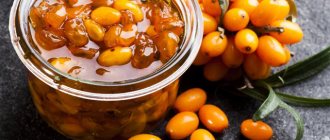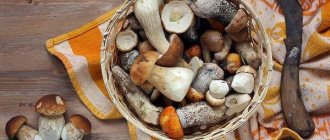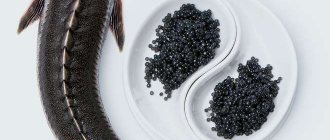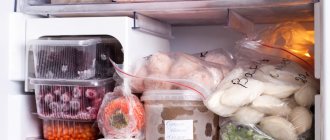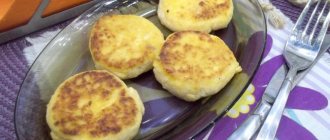Hi: I very often cook delicious dishes using gelatin. Always working with gelatin, I was afraid to boil it or accidentally pour cold water on it. I heard somewhere that you can’t boil gelatin and pour cold water over it.
I cooked with such thoughts and fears - I was afraid of everything, until today. I haven’t decided on an inexpensive experiment with gelatin yet.
Gelatin is not expensive. It took me a little time to try what would happen if the gelatin boiled, and what to do with it.
- pour 1 sachet of gelatin with warm boiled water, - leave for 30 minutes, - pour into a saucepan, - add a mug of warm boiled water, - stirring, bring to a boil, - boil, - cool not in the refrigerator, but stand on the table (cools quickly) , — put it in the refrigerator for 3 hours.
In my thoughts: - has it frozen, - has it not frozen, - has it curled up into balls, - has it lost its properties.
In just 3 hours, a jelly-like mass began to form. I left it to harden overnight. In 9 hours. The gelatin froze and it turned out to be a jelly-like mass.
Conclusion: Boiled gelatin hardens for more than 3 hours, from 10 to 12 hours.
- pour gelatin with cold water, - leave for 30 minutes, - put in a water bath, - heat,
- I cool, - I put it in the refrigerator for 3 hours.
The jelly-like mass is ready.
Conclusion: gelatin hardens faster if it is only heated well.
So, it’s clear, no matter how sophisticated I am with it, no matter how I cook it, you can boil it - but it will harden longer than the allotted time.
Attention: if the gelatin has just boiled and you have only managed to remove it from the heat, then you can use this gelatin. The mass sets and the dish is formed.
Does boiling gelatin lose beneficial substances?
First, you need to understand what it is made of: - from bones, ligaments and tendons that are boiled down by machine. Protein is extracted, which is then dried and packaged - then the manufacturers are silent about what they add there (the secret of production technology). One thing is clear: 100 grams of gelatin contains 87.2% protein. Protein is known to be a source of allergies. Eating too much protein can trigger allergies. In the case of boiling gelatin (and I tested it experimentally, the mass hardens but it takes longer) it is not known what happens to the protein, in theory it should curdle, but this does not happen, therefore chemistry is added to the gelatin bag.
Read the instructions on the bag - heat without boiling! This is a recommendation, not a warning.
No one has yet died from gelatin after consuming it in moderation.
Conclusion: the protein does not coagulate, which means that the chemical composition restrains it, leaving it at the desired consistency.
You can use boiled gelatin, but there is always a different dosage - each person has their own.
How many culinary misconceptions wander from book to book, and we take them on faith, sometimes without questioning this or that statement. But sometimes a phrase suddenly makes you think and start looking for information, and then you discover that something accepted as an indisputable truth is just another culinary misconception. Let's see, for example, whether gelatin can be boiled.
So, GELATIN. What do we know about how to use gelatin correctly? We know that gelatin should never be boiled! Why? Its gelling properties deteriorate. Or - scary to say! - completely disappear! And why? The jelly may become cloudy. Interesting interesting….
Why do the gelling properties disappear?
But no one explains this anywhere! This is not in any cookbook. And there can be no explanation for this. Because this is another culinary myth. And I can now prove this, since I performed a simple but objective experiment.
But first, about what kind of gelatin is on sale:
- Gelatin varies according to the type of raw material from which it is obtained. There is gelatin of meat origin and fish. Fish gelatin is more expensive because its production process is more complex. In addition, fish gelatin is less soluble in water.
- Gelatin varies in degree of purification, which affects its solubility and gelling properties. The purer the gelatin, the higher its gelling properties and the faster it dissolves at a lower temperature.
- Gelatin comes in different forms - sheets, granules and powder. Professional chefs prefer to work with sheet gelatin, citing its ease of use.
Is it possible to boil gelatin?
Task: find out what exactly happens to jelly if gelatin is boiled?
- Apple juice - 2 glasses.
- 2 types of powdered gelatin - fish and meat, 7 g each (1/2 sachet).
- Since fish gelatin is less soluble, it must be pre-soaked - this is written on the label. I poured 1 glass of juice, poured gelatin on top, and let it swell. By the way, this is important - gelatin is always added to the liquid, and not vice versa! Otherwise, it sticks together into lumps that may remain even after heating.
- Meat gelatin did not require pre-soaking; there was an instruction on the box - pour the bag into 1 tbsp. liquid, bring to a boil and simmer for 1-2 minutes. Pour it in, stir it, put it on the fire, cook for 2 minutes over very low heat, pour 1/2 cup into cup number 1.
- The remaining 1/2 cup was boiled over high heat for about 5 minutes. The mixture bubbled and was reduced by half. I poured it into cup number two.
- Heat the fish gelatin, stirring, without boiling, to 60-70 degrees (according to the instructions on the label) until the gelatin has dissolved. I poured 1/2 cup into cup number 3.
- Bring the remaining fish gelatin to a boil, cook for 5 minutes, pour into cup number 4.
- I put the cups in the refrigerator for 3 hours.
- I put the jelly on plates.
- the jelly turned out in 3 cups (1, 3, 4) - equally stable - where I didn’t boil the gelatin, but in one cup, number 2 - not just stable, but cool, in the picture you can see how it clearly follows the shape of the bottom ! The jelly turned out transparent even when there was a vigorous boil.
So, the answer to the question: is it possible to boil gelatin:
- gelatin can be boiled
— jelly does not become cloudy from vigorous boiling
However, where did the myth come from and why is it so tenacious?
But there is an explanation for this!
You can boil gelatin, but not in all cases you need to do this, it all depends on what and how you are preparing with it.
1. If there is a high concentration of gelatin in the liquid, you cannot boil it!
For example, for cold cheesecakes or to stabilize cream, gelatin is diluted in a small amount of water or milk, and then mixed with cottage cheese or cream. In this case, it cannot be heated longer than required for complete dissolution.
LiveInternetLiveInternet
But first, let’s talk about what kind of gelatin is on sale. 1. Gelatin differs according to the type of raw material from which it is obtained. There is gelatin of meat origin and fish. Fish gelatin is more expensive because its production process is more complex. In addition, fish gelatin is less soluble in water. 2. Gelatin varies in degree of purification, which affects its solubility and gelling properties. The purer the gelatin, the higher its gelling properties and the faster it dissolves at a lower temperature. 3. Gelatin comes in different forms - sheets, granules and powder. Professional chefs prefer to work with sheet gelatin, citing its ease of use. One sheet of gelatin weighs 4 grams, this makes it very easy to calculate the required amount and ensures greater accuracy. In addition, there is no need to worry about the exact amount of liquid for soaking - the sheets will absorb only the necessary amount for swelling. In addition, sheet gelatin is marked by the strength of the jelly that is formed, which is very important if the jelly is used to create complex, artistic desserts. At home, all this is not significant and you can safely use powdered gelatin. Moreover, you can buy sheet gelatin in Israel only in specialized stores, such as “Mr. Cake”, etc. since leaf gelatin is made from pig skin. Task: find out what exactly happens to jelly if gelatin is boiled? Given: 1. Apple juice - 2 glasses. 2. 2 types of powdered gelatin - fish and meat, 7 grams of each (1\2 bags). Actions: 1. Since fish gelatin is less soluble, it must be pre-soaked - this is written on the label. I poured 1 glass of juice, poured gelatin on top, and let it swell. By the way, this is important - gelatin is always added to the liquid, and not vice versa! Otherwise, it sticks together into lumps that may remain even after heating. 2. Meat gelatin did not require pre-soaking; there was an instruction on the box - pour the bag into 1 tbsp. liquid, bring to a boil and simmer for 1-2 minutes. I poured it in, stirred it, put it on the fire, cooked for 2 minutes over very low heat, poured 1/2 cup into cup number 1. 3. Boiled the remaining 1/2 cup over high heat for about 5 minutes. The mixture bubbled and boiled down by half. I poured it into cup number two. 4. Heat the fish gelatin, stirring, without boiling, to 60-70C (according to the instructions on the label), until the gelatin has dissolved. I poured 1/2 cup into cup number 3. 5. Bring the remaining fish gelatin to a boil, cook for 5 minutes, pour into cup number 4. 6. Place the cups in the refrigerator for 3 hours. 7. Placed the jelly on plates.
Result: - the jelly turned out in 3 cups (1,3,4) equally stable - where I did not boil the gelatin, but in one cup, number 2 - not just stable, but cool, in the picture you can see how it clearly repeats the shape bottom! the jelly turned out transparent even when there was a vigorous boil. Conclusions: - gelatin can be boiled - the jelly does not become cloudy from vigorous boiling However, where did the myth come from and why is it so tenacious? But there is an explanation for this! You can boil gelatin, but not in all cases you need to do this, it all depends on what and how you are preparing with it. 1. If there is a high concentration of gelatin in the liquid, you cannot boil it! For example, for cold cheesecakes or to stabilize cream, gelatin is diluted in a small amount of water or milk, and then mixed with cottage cheese or cream. In this case, it cannot be heated longer than required for complete dissolution. With a small volume of liquid, the solution turns out to be thick and viscous, so with prolonged and strong heating, the jelly will quickly thicken, lumps will form, the gelatin may generally burn and have an unpleasant aftertaste. However, if you are lazy and the jelly heats up to a boil, nothing bad will happen, the jelly will turn out, no need to pour it out and start all over again. 2. If the concentration of gelatin in the liquid is low, you can boil it! If the jelly is made from juice, fruit puree or broth, then in this case gelatin is added to a large amount of liquid and it can be heated for a long time, at boiling temperature, but one should take into account the fact that the liquid will boil down, so the concentration of gelatin will increase. Excessive concentration can negatively affect the taste, making the jelly too dense, and the taste of gelatin more distinct. However, if the recipe says: cook, you can do it safely, there is no error in the recipe. 3. Jelly may become cloudy from strong boiling if it is prepared from raw materials of animal origin! If the jelly is made from fish or meat broth, it must be cooked like a broth - at a barely noticeable boil, otherwise it will become cloudy. But it’s not the gelatin that becomes cloudy—it’s the broth itself! Therefore, at the end of cooking, it can be clarified in the same way as broth without gelatin is clarified. Fish gelatin is preferable to meat gelatin. The experiment showed that with equal starting conditions, the jelly turned out much tastier! I conducted an independent experiment on volunteers, not trusting my own feelings, but everyone pointed to cups of fish gelatin jelly as tastier! To calculate the required amount of gelatin, I use the advice from the book “Desserts” (Good Kitchen series): “If you want a stable jelly without a mold, take 15 grams of gelatin for every 0.6 liters of liquid, then the jelly will support its own weight. If the jelly is served in a mold, you can reduce the amount of gelatin by 15-20%.” By the way, this is why gelatin is packaged in 14 g bags - 1 bag is for 500 ml of liquid. But if we are talking about other raw materials - proteins, cottage cheese - the ratio may be different. rely on the recipe and your own experience! This calculation is correct for making jelly from liquid - water/juice. When thick or semi-liquid mixtures are gelled, gelatin works differently and here the proportions sometimes have to be selected experimentally. Let's say, my experience states that for a cold cottage cheese cake made from 500 g of cottage cheese + 200 g of sugar + 500 ml of heavy cream (= 1200 g), 20 g of gelatin is completely sufficient, since the cottage cheese and cream already form a fairly stable structure (when cold, of course). To introduce gelatin evenly into the gelled mixture , you need to equalize the temperature as much as possible. Jelly mixture d.b. room temperature. A small part of it needs to be added to the gelatin, stirred thoroughly, and then, with continuous beating or stirring, the gelatin mixture is poured into the gelatine mixture. I repeat - all this applies only to those cases when the cream/soufflé is gelled. Useful advice from Irma Rombauer ("Culinary Bible") Some fruits contain enzymes that destroy collagen, so jelly from juice or puree with such fruits does not harden (kiwi, pineapple, lemon). But if you boil the juice of these fruits, the enzymes will be destroyed and the jelly will harden. Advice from Israeli chef Eran Schwartzbard: for every gram of powdered gelatin for soaking, take 5 grams (as in the text!) of water; excess liquid affects the quality of the jelly. Can gelatin be frozen? You can. But you shouldn’t do this, especially if the jelly is transparent! Gelatin does not lose its gelling properties. But as a result of freezing, the jelly becomes cloudy and loose, because... water particles, expanding, destroy its structure.
Dilution of gelatin for jellied meat
Jellied meat does not always harden without gelatin. To avoid ruining the dish, you need to know how to properly dilute it specifically for jellied meat.
The powder is pre-soaked in a glass of cold boiled water for one hour. When the granules swell, the mixture is poured into a suitable container and placed on low heat or in a steam bath. With constant stirring, the container with the contents should be kept on the fire until the granules are completely dissolved. But the liquid must not be allowed to boil , as its properties will be lost.
The granules dissolved in water must be filtered and combined with the broth for jellied meat. Mix thoroughly.
If you know in advance that powder will be used to prepare jellied meat, then the carrots for it need to be chopped very finely.
To get a normal consistency of jellied meat, it is enough to take 20 grams of powder per liter of liquid. If you take a larger portion of powder, the dish will turn out harder and denser. But this will not affect its taste and appearance in any way.
You can make sure that the right amount of powder is taken using your own fingers. To do this, they need to be wetted with the prepared liquid. If they stick, but detach from each other easily enough, this means that enough powder was taken for preparing the dish.
How to use gelatin correctly at home
So, we have solved the problem with recalculation; all that remains is to study the rules for working with gelling thickeners.
Rule #1: Soak gelatin correctly
Confectioners have two main ceremonies: accurately weigh the ingredients, and soak the gelatin in water. The magic of making mousses, creams and cakes begins with them. The tasks are generally straightforward, but the final operation depends on the type of gelatin product.
Leaf gelatin
For soaking, you need cold water 10℃. Fill the sheets with water until they are completely covered with liquid. You can use a glass or container for this. We wait 10-15 minutes until the sheets swell.
When the gelatin sheets become soft, remove them from the water and gently squeeze out excess moisture. We lower the sheets into pre-prepared hot water at 60-70℃, they will quickly disperse in it.
Powdered and granulated gelatin
Here the process is a little more complicated. For one gram of powder or granules we take 6 g of water, i.e. The formula is 1:6. for any recipe. Thus, for this method of using powdered gelatin, you can easily calculate the required amount of water.
We will also fill it with cold water, but unlike sheet gelatin, these types must completely absorb all the moisture. Be sure to take into account that each manufacturer has its own swelling time, and it varies significantly. If we take, for example, the same granular “Ewald”, then you will have to wait about 40 minutes, which not everyone can stand.
As a result, all the water is absorbed, and we get a loose gelatinous mass. However, to put it into working condition, it needs to be immersed in hot water at 60-70℃. There is an option when the mass is melted in a bathhouse or in the microwave.
In a closed container, the finished gelatin mass can be stored in the refrigerator, but not more than 72 hours. As necessary, it is removed from the cold and weighed. The required weight is determined as follows:
- We soaked in a ratio of 1:6. If the recipe calls for eight grams of gelatin, then weigh out 55 g of gelatin mass, because it will contain 8 g of thickener and water 6x8 = 48 g.
Rule #2: add it correctly
Gelatin should only be added to the hot mixture because it begins to work at temperatures above 50℃. The mass is then mixed and cooled, and in some cases frozen.
The gelation stage occurs at temperatures below 10℃, when the movement of the mixture molecules stops. The stabilization time of the dish depends on its weight and ambient temperature. In general, cake frosting is usually refrigerated for 12-24 hours.
Rule #3: Be careful with fruit!
To use gelatin correctly, you need to remember that pineapples, kiwi, papaya and some fruits contain enzymes that can destroy animal proteins. If you decide to prepare the filling with fresh fruit, then rest assured - it will certainly flow.
What to do? Bublichkina pre-boils such fruits, or uses them in canned form, which is what she advises you to do. After heat treatment, enzymes lose their aggressiveness, and you no longer have to worry about the quality of the dessert.



